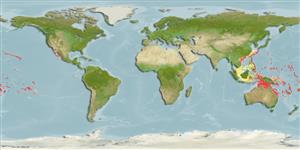Environment: milieu / climate zone / depth range / distribution range
Ecología
marino asociado a arrecife; no migratorio; rango de profundidad 21 - 81 m (Ref. 9710). Tropical; 30°N - 28°S
Pacific Ocean: Taiwan to the Tuamoto Islands, north to the Ryukyu Islands, south to New Caledonia and the Austral Islands.
Tamaño / Peso / Age
Maturity: Lm ? range ? - ? cm
Max length : 15.0 cm TL macho / no sexado; (Ref. 9710)
Espinas dorsales (total) : 15 - 16; Radios blandos dorsales (total) : 15 - 16; Espinas anales: 3; Radios blandos anales: 14 - 17. Males light blue with 8 black stripes on the lower 2/3 of the body (the posterior end of the uppermost yellow, the lowermost stripes extending the adjacent anal fin); females light blue with a vertical black bar above the eye and spots on the forehead; both sexes with a broad submarginal band on the dorsal and anal fins; females with broad submarginal band on the caudal-fin lobes.
Occurs in current-swept outer reef slopes and drop-offs (Ref. 4859). Feeds on plankton. Forms harems of 2-5 individuals. Occasionally exported through the aquarium trade (Ref. 48391).
Life cycle and mating behavior
Maturities | Reproducción | Spawnings | Egg(s) | Fecundities | Larva
Steene, R.C., 1978. Butterfly and angelfishes of the world. A.H. & A.W. Reed Pty Ltd., Australia. vol. 1. 144 p. (Ref. 4859)
IUCN Red List Status (Ref. 130435)
Threat to humans
Harmless
Human uses
Pesquerías: comercial; Acuario: Comercial
Herramientas
Special reports
Download XML
Fuentes de Internet
Estimates based on models
Preferred temperature (Ref.
123201): 24.2 - 28.7, mean 26.5 °C (based on 65 cells).
Phylogenetic diversity index (Ref.
82804): PD
50 = 0.5010 [Uniqueness, from 0.5 = low to 2.0 = high].
Bayesian length-weight: a=0.03090 (0.01359 - 0.07026), b=2.89 (2.70 - 3.08), in cm total length, based on LWR estimates for this (Sub)family-body shape (Ref.
93245).
Nivel trófico (Ref.
69278): 3.4 ±0.45 se; based on food items.
Resiliencia (Ref.
120179): Medio, población duplicada en un tiempo mínimo de 1.4-4.4 años (Preliminary K or Fecundity.).
Fishing Vulnerability (Ref.
59153): Low vulnerability (10 of 100).
Nutrients (Ref.
124155): Calcium = 77.5 [37.3, 119.0] mg/100g; Iron = 0.696 [0.415, 1.159] mg/100g; Protein = 18.2 [17.0, 19.3] %; Omega3 = 0.126 [0.074, 0.209] g/100g; Selenium = 27.6 [14.1, 54.4] μg/100g; VitaminA = 154 [43, 527] μg/100g; Zinc = 1.27 [0.85, 1.83] mg/100g (wet weight);
